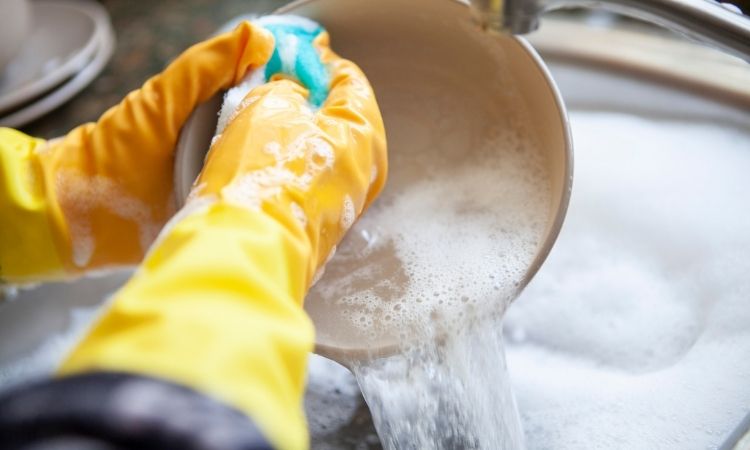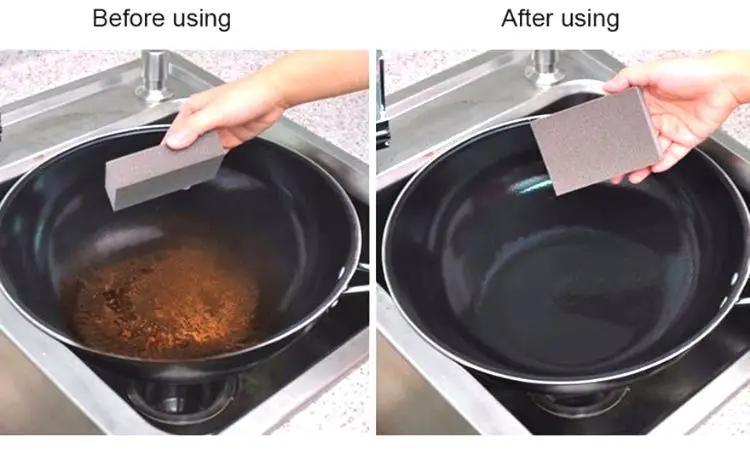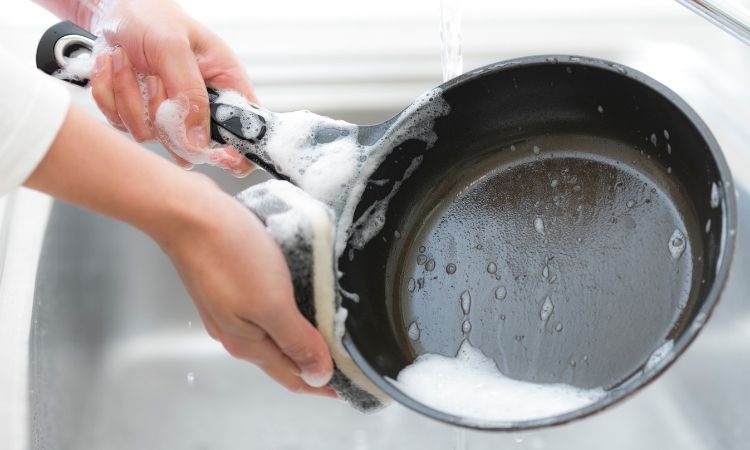
In the world of cookware, hard anodized cookware is famous for various reasons. It is precise because of its build quality and the numerous benefits that come with it. Firstly, it gives you evenly cooked food because of the even heat distribution. Secondly, it is a safer choice for kitchen use. A common cause for concern is when metal chippings get into your food, but thanks to the crucial anodizing process that makes it nonstick – it is no longer an issue. The anodized cookware is also a durable choice. The cookware exterior has a coating formed during this process that prevents scratches, chipping, and peeling. Its fine build makes it twice as hard as its usual substitute, the stainless steel. Ensuring proper care of hard-anodized aluminum cookware is of utmost importance if you want to use them in the long run.
Keeping your cookware clean is essential and knowing how to is in your best interest. Many cookwares are dishwasher-friendly, however, according to experts, it is best if you wash your hard anodized cookware by hand. Let us get an in-depth look at how to ensure your anodized cookware is always clean and on point.
Keeping Your Hard Anodized Cookware Clean
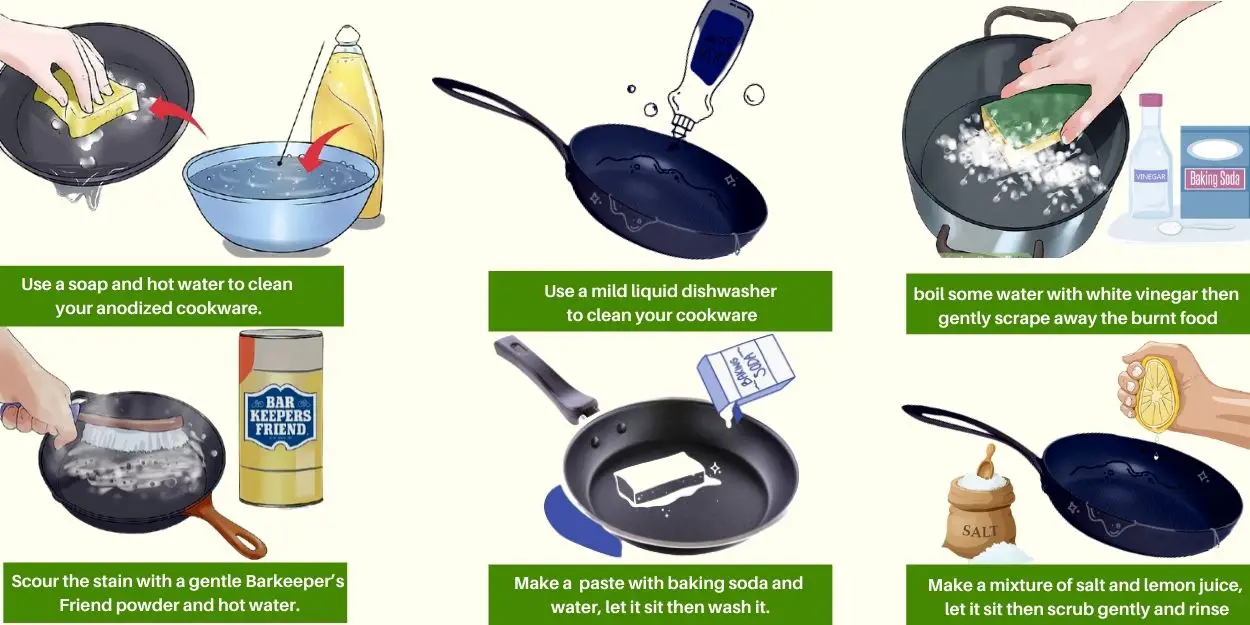
Hard-Anodized Cookware Exterior Cleaning
We all like keeping our cookware clean and our kitchen tidy. Therefore, it is only common sense to clean your pots and pans’ exterior just as your interior. However, we often make mistakes with the intent of doing both, so we have to ensure the job is done in the right way.
Is That A Wire Sponge?
What you use to clean is key to not causing unnecessary damage and discoloration. In the instruction manual, it is informed that you avoid using coarse sponge pads and wire sponges. Say no to chlorine bleach as well to prevent stains.
You may be tempted to use any household cleaning solutions for your bathroom floors or oven, thinking it will yield better results – but do not! It is in your best interest to just go with the regular soap and warm water. Instead of wire sponges, use soft dishcloths and gently scrub your way around for the most efficient results.
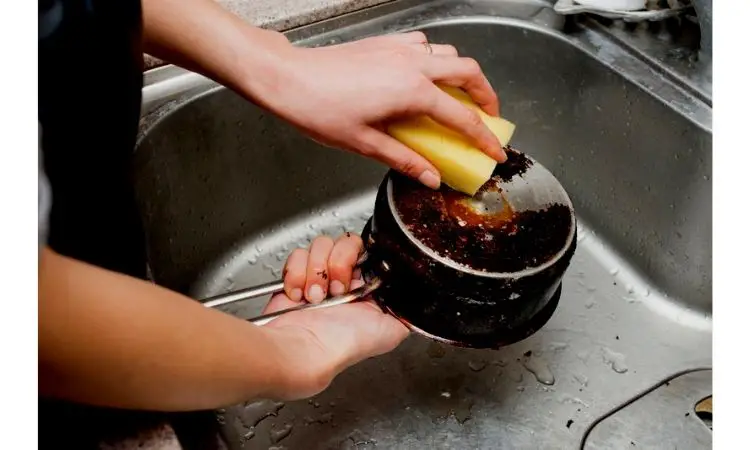 It is better to be well-informed about the extent of possible damages that can easily deter your pots and pans’ lifespan beforehand and save up on potential costs. Moreover, not following instructions from the manual will also be a blow to the cookware warranty conditions.
It is better to be well-informed about the extent of possible damages that can easily deter your pots and pans’ lifespan beforehand and save up on potential costs. Moreover, not following instructions from the manual will also be a blow to the cookware warranty conditions.
The Traditional Solution To Your Cleanup
The hard-anodized aluminum cookware is porous. Which means it is permeable to substances and therefore requires proper cleaning. Burnt foods are another common reason why there may be stains.
When you notice stains forming, remain calm, and create a baking powder and water solution. Use the solution to scrub the kitchenware with care, and that should do the job.
Down The Drain
One brilliant method is soaking your cookware pots and pans to get rid of tough stains. Using hot water and regular dish soap is fine. Soak your pots and pans, and then make sure you scrub them after with a dishcloth and rinse them with water.
Scour, Shine, Scrub & Rub
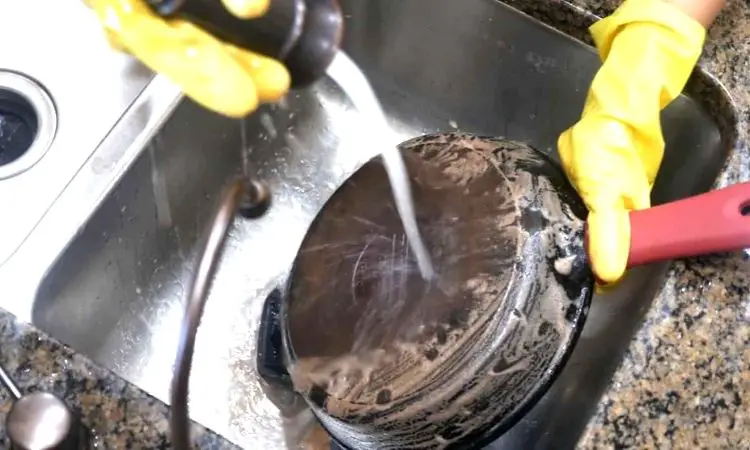 Another efficient method of cleaning the outside region of your anodized cookware is using scouring powder. Form a solution of a scouring agent and water, and you are ready to go.
Another efficient method of cleaning the outside region of your anodized cookware is using scouring powder. Form a solution of a scouring agent and water, and you are ready to go.
Traditional tip#2
Use a baking soda and water solution to get rid of burns and tough stains. Take a soft dishcloth and rub over the stains and clean them later with warm water.
Extra Tips for Cleaning the Outer Bottom Region of Your Cookware
Cleaning the bottom region can be tricky and here are a few tips to restore hard anodized cookware exterior that make your task more comfortable and effective.
Coca Cola
Using Coca Cola is famous for removing tough stains and it is quite practical to clean the bottom region of your pots and pans. Simply get a big bowl and pour the drink in. Soak your cookware and leave them there for a couple of hours. This will cause the grease to loosen up and later scrub it off gently with a soft sponge.
Baking Soda & White Vinegar
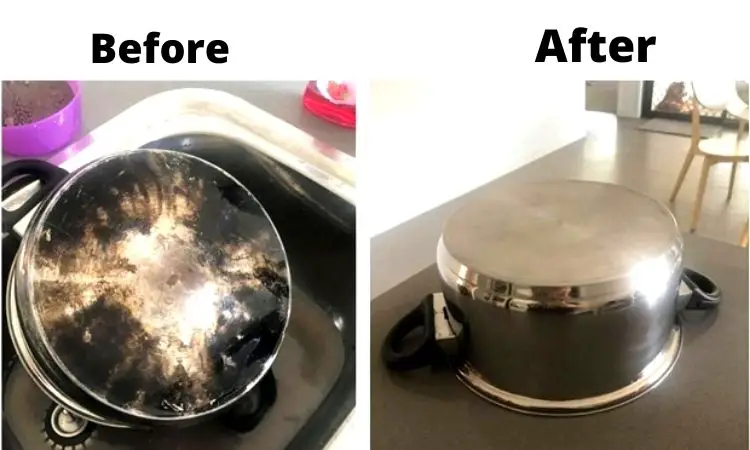 Baking soda and white vinegar is an appropriate agent for those stubborn stains. Simply form a mixture of white vinegar and warm water in a large pot and put the pan inside. Boil the mixture and let the cookware soak. After a while, turn off your stove and add baking soda to the mix. You will notice a reaction and see that the stains and greases are disappearing. Afterward, scrub and rinse the cookware for the best results.
Baking soda and white vinegar is an appropriate agent for those stubborn stains. Simply form a mixture of white vinegar and warm water in a large pot and put the pan inside. Boil the mixture and let the cookware soak. After a while, turn off your stove and add baking soda to the mix. You will notice a reaction and see that the stains and greases are disappearing. Afterward, scrub and rinse the cookware for the best results.
Restore Hard-Anodized Cookware Interior
We tend to prioritize our cookware’s interior when cleaning. This is because that is where the food is cooked. Therefore, it is best to keep the insides clean to ensure healthy cooking. Now let us look at how we can clean the insides of our cookware correctly.
Not Clean Because It’s New
We tend to use a newly bought product right after purchase. What harm could there be? It’s new, right? In spite of that, it is advised that you wash your pots and pans before using them.
Just soak them in warm water mixed with dish soap. Clean them each gently and let them dry thoroughly prior to use.
Don’t Pile Up Your Mess!
After repeated use, you may notice tough stains and grease forming on your cookware. They take the newness away. However, according to experts’ advice, washing your anodized cookware set after each use will prevent such an issue.
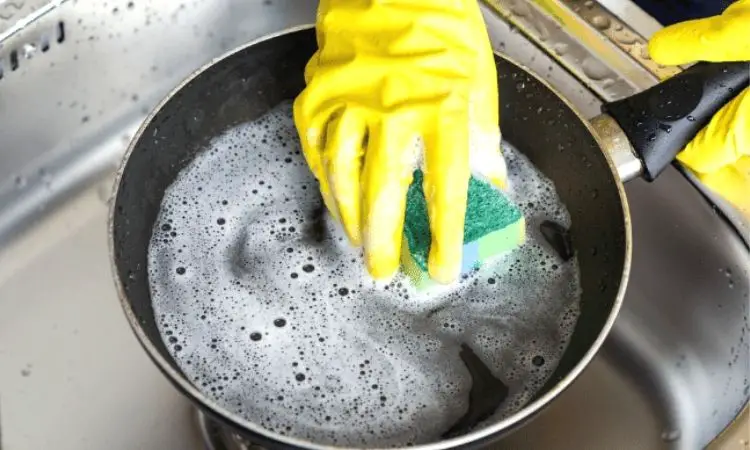 If you have hot water ready to go, then you can souse your hot pots and pans in it and avoid them getting deformed.
If you have hot water ready to go, then you can souse your hot pots and pans in it and avoid them getting deformed.
However, dipping the nonstick pots and pans in cold water right after cooking can cause them to deform. In order to avoid that, let your cookware cool beforehand.
The Traditional Path To Take
The combo of hot or warm water and mild soap will be the companions you will need during your journey with anodized cookware. Making sure the newness remains in your cookware in the long run, will require rinsing them with this solution.
Scour, Shine, Scrub & Rub (again)
You can use scouring agents to get rid of tough stains from time to time on your anodized pots and pans, but make sure they are mild. You may want to purchase a collection of soft-bristled brushes for cleaning purposes and avoid any concern for damage at all.
Simmer Down!
This is one of those cool tricks. It involves soaking the anodized cookware set in a water and dishwashing liquid solution. Afterward, let the pots and pans simmer in the water for about 20 minutes. Separate the pots and pans from the solution and let them cool for about half an hour.
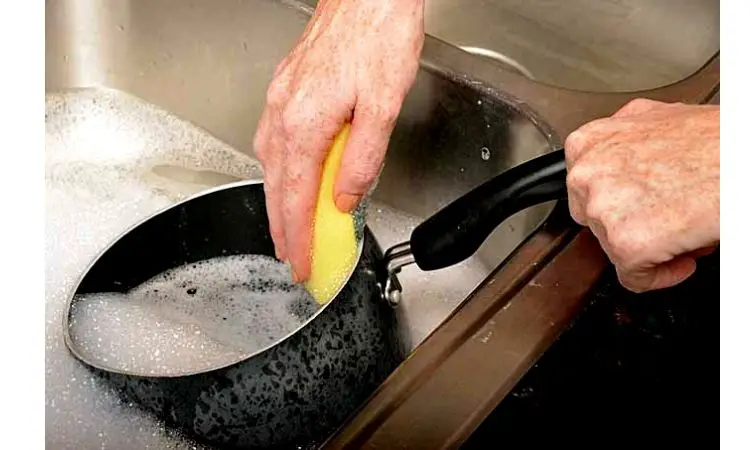 What this does is, it allows the grease to become loose. So after, you can gently scrub the grease stains off using those soft-bristled brushes as mentioned earlier. Make sure to use lots of water to rinse the cookware set.
What this does is, it allows the grease to become loose. So after, you can gently scrub the grease stains off using those soft-bristled brushes as mentioned earlier. Make sure to use lots of water to rinse the cookware set.
Here’s another more efficient way of doing the same thing; just follow the same course of action, except replace the dishwashing liquid with vinegar. Vinegar is the catalyst in this process as it only requires around 5 to 10 minutes.
Old School Tip
Mixing water and cream of tartar is a highly effective solution to removing tough stains. Just apply the paste, leave it for 10 minutes, and then using a soft sponge scrub away. This gives your pots and pans a brighter and shiny appearance as well as keeping them clean.
Maintaining Your Cookware for the Long Haul
We have looked at the essentials of cleaning your cookware for getting the best results. While cleaning is a major factor that will give your cookware a longer lifespan, maintenance is key as well. Owning a set of hard anodized cookware is like owning a cat; while you feed it and keep it clean, it is also important to keep in mind what not to do with it.
Avoid using metal utensils to scrape, turn or stir your food, and avoid using them to blend or remove food from the pan. Instead use wooden, plastic, or silicone utensils that are best for your nonstick cookware. Moreover, don’t cut portions that will go directly into the pan using metal utensils like a metal knife right in the pan. What happens then, is that the coating of cookware is pierced and loses appearance as a whole. When repeated, scratches can form, and the coating can peel off, and rusts will form.
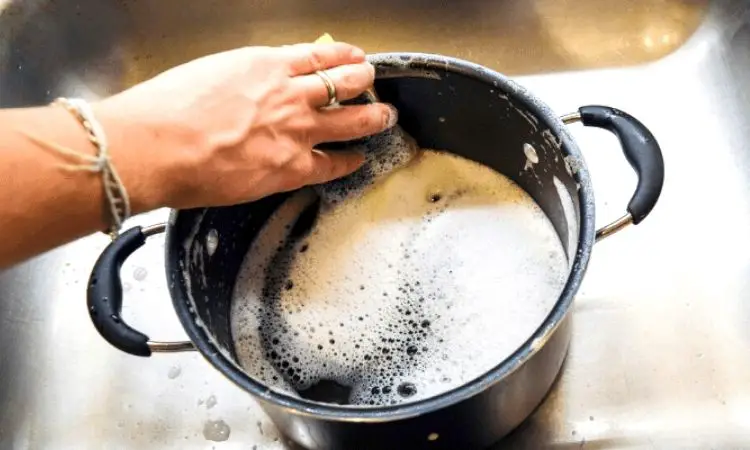 Another hindrance relating to appearance is the cleaners used. Refrain from using metal-based scrubbing pads or cleaners with hard bristles because that will cause the coating to wear off over time. Instead, be a little patient, let your pots and pans soak in the dishwater for a while to allow the residue to loosen up so you can simply scrub the remains off gently using a soft dishcloth. Choose soft sponges and plastic scrubs over metal-based ones and you will be better off. Moreover, always double-check for leftovers and tough stains because any such remains will stick to your cookware when heated up.
Another hindrance relating to appearance is the cleaners used. Refrain from using metal-based scrubbing pads or cleaners with hard bristles because that will cause the coating to wear off over time. Instead, be a little patient, let your pots and pans soak in the dishwater for a while to allow the residue to loosen up so you can simply scrub the remains off gently using a soft dishcloth. Choose soft sponges and plastic scrubs over metal-based ones and you will be better off. Moreover, always double-check for leftovers and tough stains because any such remains will stick to your cookware when heated up.
Do you notice one half of your pancake burning deeper than the other? This is happening because of uneven heat distribution. An uneven heat distribution results from consistent warping over a period of time. Prevent your pots and pans from warping by staying proactive and alert about extreme changes in water temperature. Make sure you don’t place a hot nonstick pan into cool dishwater right away because that causes warping.
According to experts worldwide, washing your cookware in dishwashers is not recommended. You may have noticed what happens to your bright and shiny frypan after a wash in the dishwasher; they turn colorless, lose their shininess, and the coating wears off. Moreover, the detergent used in dishwashers is generally too harsh for your cookware and so it is best to avoid that pathway and go with simple manual clean up.
Prevention & Decluttering the Cleanup Process
If we can prevent tough stains and greases from forming, we can avoid dishes piling up that are hard to clean. This not only declutters your cleanup process but also allows for better maintenance of your cookware. Consider these tips:
 The Pits Of Hellfire
The Pits Of Hellfire
Our stovetops go through literal hell as we keep cooking over the same surface over time. We spill oil, sauce, sticky substances, and later, these form hard-to-clean residues on the stovetop. If we pay attention to this segment of our cooking procedure, we will easily simplify our entire kitchen experience – as these are codependent. One smart way to tackle this issue is, placing foil paper, wax paper, or parchment on your pots and pans; they will prevent foods from sticking to the surface and causing burns.
Grease For No Grease?
This is a very common tip, yet it is smart. Prior to cooking, grease your pan with butter or oil. The oil soaks into the orifice of the pan and once heated, forms a nonstick coating.
You can also grease your pan with oil and pre-heat it. Pre-heating it with medium heat will disallow the food from sticking to the pan or forming stains.
What Season Is It?
Seasoning your pan does the same job as greasing it to get a nonstick surface. Your goal is to produce a corrosion-free surface by seasoning it with heated fat. Even though anodized aluminum cookware is generally corrosion-free, it is still an effective method to prevent greases with a nonstick surface.
How to Clean Burnt Anodized Cookware
Barkeeper’s Friend
A reputable cleaning agent in powder or mild cleanser form will be beneficial for burnt stains. Wash your pot or pan in lukewarm water and sprinkle the cleaning agent on the regions that are burnt. Gently scrub those regions with a soft sponge in circular motions for some time, and then wash it off and let it dry.
Magic Eraser
Mr. Clean’s hardcore eraser cleans any tough stain simply by being rubbed over them repeatedly. Rinse your cookware and rub the eraser on the affected region. Keep rubbing consistently and rinse again afterward; that will do the job.
 Salt & Lemon
Salt & Lemon
This is a more traditional method and always effective. Both salt and lemon are used separately as cleaning agents but combining them give you a powerful solution to getting rid of burnt stains.
Create a solution by adding two spoons of salt and one and a half spoon of lemon juice. Put in the mixture on the affected areas and leave it like that for 30 minutes to an hour. Scrub gently and rinse well.
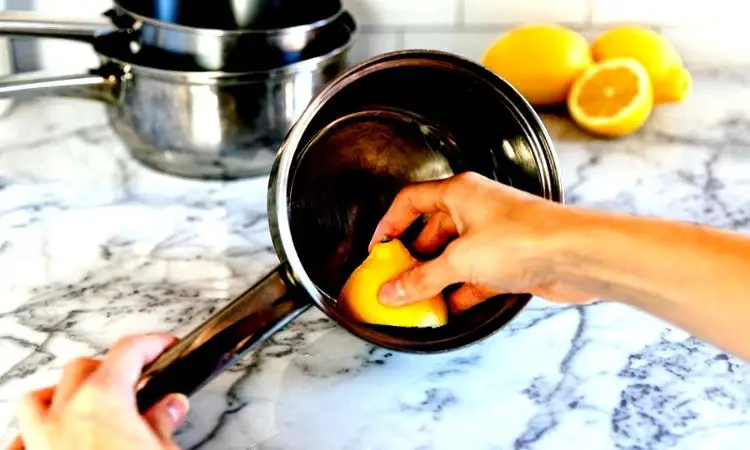 Final Verdict
Final Verdict
Even though hard anodized cookware is recommended as the best choice by chefs and experts all around, people are, at times hesitant. This is normal because you would not want to invest money in a long-term product to have it damaged because you could not take care of it. However, anodized cookware is a good fit for any kitchen and all you need is proper knowledge of care, and your pots and pans will last longer. Following the guidelines above regarding cleaning and maintaining the quality of your hard anodized cookware set will ensure they are a worthy investment.

